![]()
![]()
![]()
Use LEFT and RIGHT arrow keys to navigate between flashcards;
Use UP and DOWN arrow keys to flip the card;
H to show hint;
A reads text to speech;
76 Cards in this Set
- Front
- Back
- 3rd side (hint)
|
This era in English cultural history is sometimes referred to as “The Age of Shakespeare" or “The Elizabethan Era." |
English Renaissance |
|
|
|
What two line of monarch occupied the throne during English Renaissance? |
Tudor and Stuart monarchy |
|
|
|
Five people who occupied the Tudor monarchy |
Henry VII, Henry VIII, Edward VI, Mary, Elizabeth I |
|
|
|
What about the Stuart monarchy? |
James I and Charles I |
|
|
|
Was considered a great benefactor of the art and architecture so during this period flourished |
Henry VIII |
Tudor Period |
|
|
Was considered to be the age of prosperity the height of English renaissance. |
Elizabethan I |
The Virgin Queen |
|
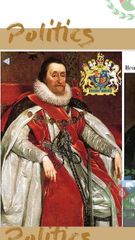
First Stuart king of England from 1603 to 1625, who styled himself “king of Great Britain.” |
James I |
Was king of Scotland before he became king of both England and Scotland |
|
|
TUDOR'S FASHION |
---- |
|
|
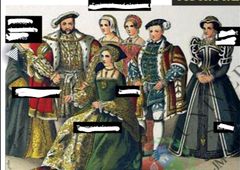
Label the Parts |
From left to right: 1. Puffed, detachable sleeves 2. Slashed doublet 3. Trumplet sleeves 4. Embroided plastron 5. Bodice 6. Partlet collar 7. Kirtle |
|
|
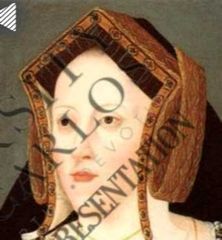
Is an English woman's headdress of c. 1500–1550, so-called because its pointed shape resembles the gable of a house. |
Gable hood |
|
|
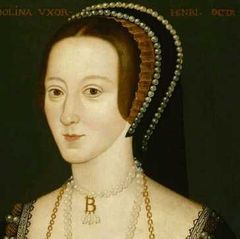
The half moon or crescent shaped style was a glorified head-band with a veil attached at the rear. |
French hood |
|
|
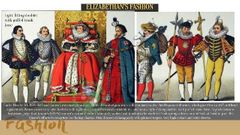
ELIZABETHAN'S FASHION |

------- |
|
|
|
ART🖌 Tudor Period |
-------- |
|
|
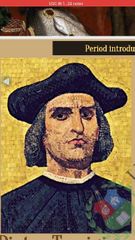
He was important in introducing Renaissance art to England, but his career was adversely affected by his violent temperament. |
Pietro Torrigiano |
|
|
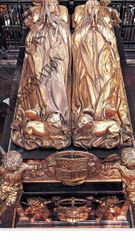
Name |
TOMB OF KING HENRY VII AND QUEEN ELIZABETH OF YORK |
|
|
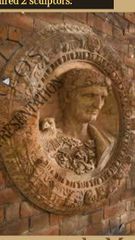
was an Italian sculptor employed by Henry VIII of England and Cardinal Wolsey to decorate their palaces |
Giovanni da Maiano |
|
|

Name |
Bust of Tiberius |
|
|
|
ARCHITECTURE🏛 |
----- |
|
|
|
Is often considered to be a golden age in English history. ● Emphasis on symmetry ● Classical concepts of planning |
Elizabethan Era |
|
|
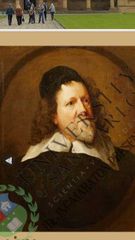
He introduced Renaissance Classicism into England. Studied architecture by Andrea Palladio |
Inigo Jones |
Royal Architect of England |
|
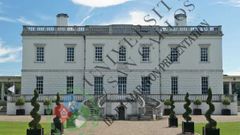
Queen's House is a former royal residence built between 1616 and 1635 in Greenwich, a few miles down-river from the then City of London and now a London Borough. |
Queen’s House, Greenwich |
|
|
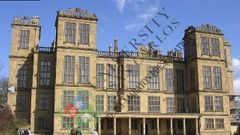
An architecturally significant Elizabethan country house in England, a leading example of the Elizabethan prodigy house. Built between 1590 and 1597 for the formidable Bess of Hardwick |
Hardwick Hall by Robert Smythson |
|
|
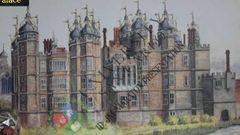
Favorite home of the Queen Elizabeth |
Richmond Palace |
|
|
|
INTERIOR DESIGN🛠 |
---- |
|
|
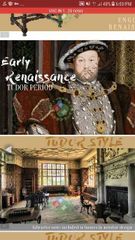
INTERIOR DESIGN TUDOR PERIOD |
Libraries were included in homes in interior design |
|
|
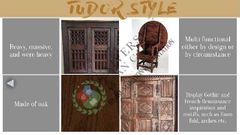
Tudor Style |
---- |
|
|
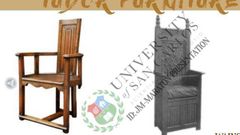
1. Derived from the the French gossip chair and featured a trapezoidal chair 2. Typical antique tudor chair, called “settee chair” had a tall straight back and sturdy arm support and were box like form with an enclosed area for storage as a kind of cupboard |
1. Caquetoire 2. Wainscot Chair |
|
|

1. Can be used either as chair or table, usually circle/ square hinged back 2. Used by the master of the house and his family, stood on a dais at the end of the room |
1. Chair table. 2. Table dormant |
|
|

1. Designed for food storage and had pierced carving for ventilation on the front 2. A tall storage unit used for storage of linen or clothing |
1. Aumbry 2. Press |
|
|
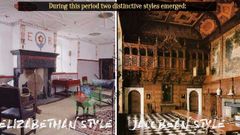
TWO DISTINCTIVE STYLES |
1. Elizabethan Style 2. Jacobean Style |
|
|
|
CEILING |
------ |
|
|
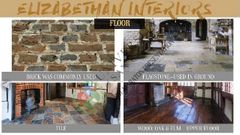
FLOOR |
---- |
|
|
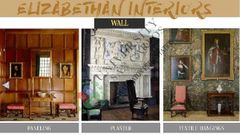
WALL |
----- |
|
|
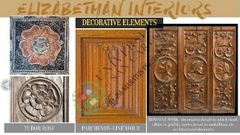
DECORATIVE ELEMENTS |
----- |
|
|
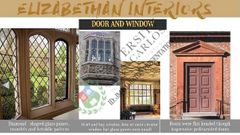
DOOR AND WINDOW |
----- |
|
|
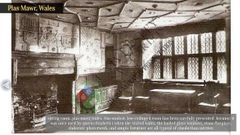
Plaw Mawr |
---- |
|
|
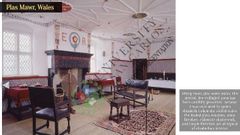
Plas Mawr |
----- |
|
|
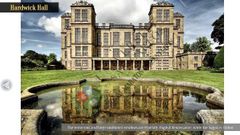
Hardwick Hall |
---- |
|
|

ELIZABETHAN FURNITURE |
----- |
|
|

ELIZABETHAN FURNITURE |
----- |
|
|
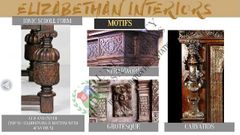
MOTIFS |
------ |
|
|
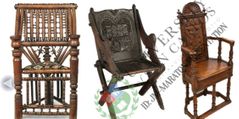
1. TURNINGS / TRIANGULAR IN PROFILE 2. X FRAMED FOLDING CHAIR 3. GOSSIP CHAIR |
1. Thrown or Turned Chair 2. Glastonbury Chair 3. Caquetoire |
|
|
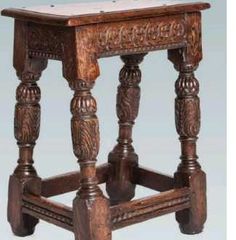
Carved and turned oak • Has a wooden seat • The underframing of the stool usually followed the style characteristics for chairs |
Joint Stool |
|
|
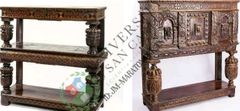
1. SHORT CUPBOARD 2. CARVED INLAID OAK AND WALNUT |
1. Court Cupboard 2. Hall Parlor Cupboard |
|
|

Label Label Label Label Label Label Label Label |
From top to bottom:1. Strapwork decoration2. Arcaded panel3. Tudor rose4. Anthemion motif5. Cup and cover6. Lozenge panel |
|
|

1. • Carved frieze. • Cup and cover legs with gadroon above the carving below. • Capped with an Ionic capital • Doubles its original length when fully extended the tabletop 2. |
1. Draw table 2. Draw-top table |
|
|
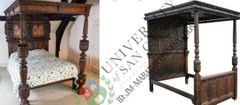
Large and elaborately decorated after the mid 16th canopies or tester were supported by posts at the foot and by the headboard. • rich and elaborate carvings • monumental forms • Paneled and carved headboard • Two front posts were completely detached from the bed and stood beyond it • Bedposts were usually bulbous-shaped and rested on massive pedestals |
Tester bed |
|
|
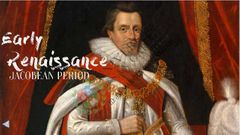
JACOBEAN PERIOD |
---- |
|
|
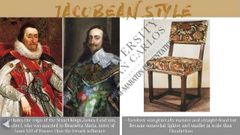
JACOBEAN STYLE |
----- |
|
|
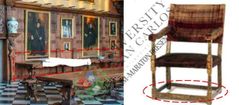
1. Pilaster were being used to divide wainscoting in interiors 2. |
1. Wainscotting 2. Perimeter stretcher |
|
|
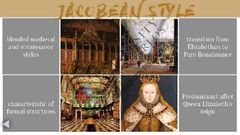
JACOBEAN STYLE |
---- |
|
|
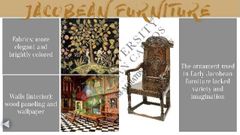
JACOBEAN FURNITURE |
---- |
|
|

Is a jacobean english interior of exceptional richness. it has richly carved woodwork and an ornate painted plaster ceiling. the woodwork, hanging tapestries, and elaborately carved furniture contrast with the simple tiled floor. |
Great Hall, Hatfield House, England |
|
|

Label from top to bottom: |
1. Pargework ceiling 2. Pendant 3. Cornice 4. Arcaded panel 5. Bed with decorative bed hangings 6. Composite panel 7. Candlestick 8. X-form chair |
|
|
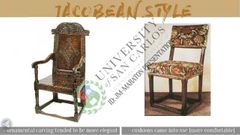
JACOBEAN STYLE |
----- |
|
|
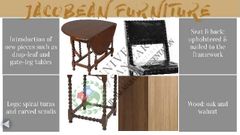
JACOBEAN FURNITURE |
----- |
|
|

1. Featured wainscoting simulating the wall paneling 2. Prominent in the early 17th century, this was upholstered armless chair designed to accommodate the fashion for extreme width in women’s dresses |
1. Jacobean Wainscot chair 2. Farthingale chair |
|
|
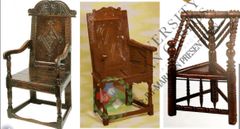
1. 2. THESE CHAIRS WERE SOMETIMES CALLED “-----” CHAIRS AFTER THE EARLY TERM FOR TURNING. THIS FINE EXAMPLE IN ASH (c1650), HAS A BALUSTERTURNED BACK SPLAT, RING-TURNED TOPRAIL WITH BUTTON FINIALS AND BOBBIN-TURNED SPINDLES. |
1. Jacobean Armchair 2. Thrown Armchair |
|
|
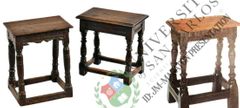
1. 2. THEY WERE MADE BY JOINERS USING THE MORTISE AND TENON TECHNIQUE, THEY TEND TO BE OF BETTER QUALITY THAN STOOLS MADE BY TURNERS OR CARPENTERS. THIS SOLIDLY MADE OAK STOOL, WITH TURNED LEGS AND BLOCK FEET, IS PART OF A SET OF SIX. SUCH 17TH CENTURY (c1600) SETS ARE RARE, SINCE THEY HAVE NORMALLY BECOME DISPERSED OVER TIME. - W 18in / 46cm. |
1. Oak Joint Stool with Baluster Turned Splayed Legs 2. Joint Stool |
|
|

1. Crimson silk velvet cushions and gold fringes enrich this furniture. it is basically simple in form with small-scale carved detail. •Seat Opening Into a Chest •Double-purpose Seat and Table |
1. CARVED OAK TABLE-SETTEE |
|
|

1. 2. Folding Top Resting on a Gate Support Frieze Carved with Strapwork |
1. Gate-leg table 2. Oak side table |
|
|

THIS TABLE DATES FROM c1660-80 (LATE RENAISSANCE), AND IS TYPICAL OF THE TYPE, WITH A PLANK TOP ABOVE ABOUT A CARVED FRIEZE RAIL SUPPORTED BY SIX LEGS UNITED BY STRETCHERS. IN THIS INSTANCE, THE LEGS ARE OF MODIFIED BALUSTER FORM; INELIZABETHAN TIMES THEY WOULD PROBABLY HAVE BEEN CUP AND COVER IN STYLE. REFECTORY TABLES ARE USUALLY MADE OF OAK, BUT WALNUT AND YEW TABLES ARE ALSO FOUND. - L9ft X 30in; L 2.74m X L76cm |
1. Oak Refectory Table |
|
|

Name |
1. OAK AND LINEN FOLDING TABLE, 15TH CENTURY CARVED 2. OAK SIDE TABLE, ENGLISH, ABOUT 1500 |
|
|

1. 2. |
1. OAK AMBRY WITH FOLIATED IRONWORK, ENGLISH, ABOUT 1450. 2. OAK CHEST STOOL WITH ROMAYNE MEDALLIONS, ENGLISH, ABOUT 1500-1550 |
|
|
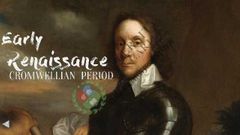
CROMWELLIAN PERIOD |
---- |
|
|
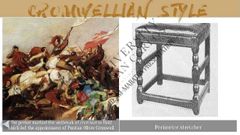
CROMWELLIAN STYLE |
---- |
|
|
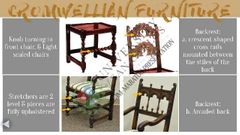
CROMWELLIAN FURNITURE |
---- |
|
|
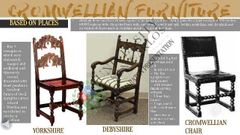
Familiarize |
---- |
|
|
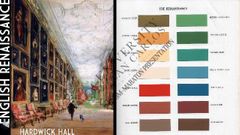
COLORS USED IN ENGLISH RENAISSANCE |
---- |
|
|
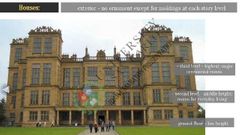
Familiarize |
---- |
|
|
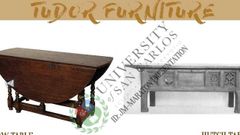
1. Had layers so constructed that the lower leaves could be pulled out at each end and the upper portion would drop down between them, doubling the table area; leaves were supported by runners 2. A serving table with cupboard that was placed against the wall and used as side table. |
1. Draw table 2. Hutch table |
|
|
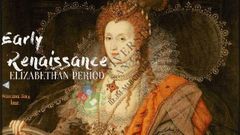
ELIZABETHAN PERIOD |
----- |
|
|
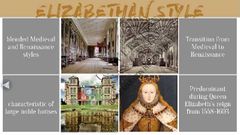
ELIZABETHAN STYLE |
------ |
|
|
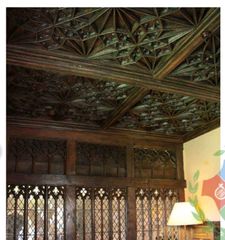
Name |
Carved wood |
|
|
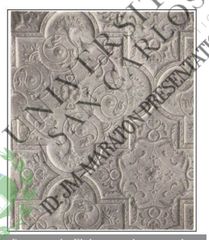
Elaborate plasterwork; especially an ornamental facing for plaster walls decorated with figures in low relief. |
Pargework |
|
|
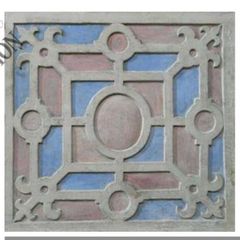
is the use of stylised representations in ornament of ribbon-like forms. These may loosely imitate leather straps, parchment or metal cut into elaborate shapes, with piercings, and often interwoven in a geometric pattern. |
Strapwork |
|

